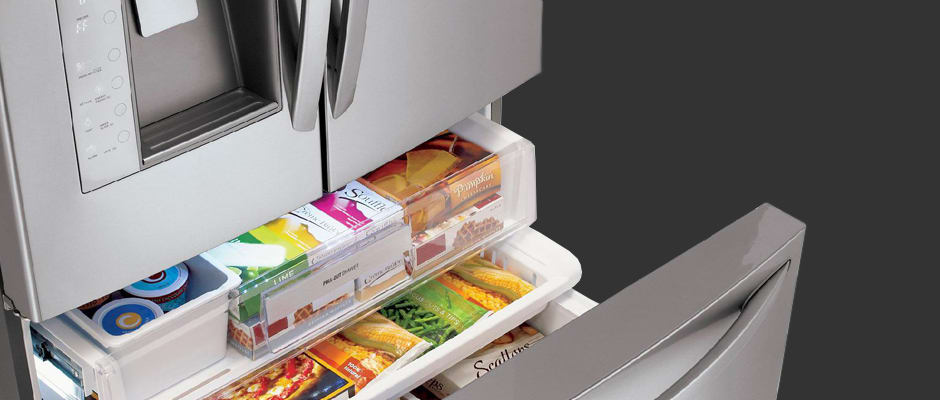Pros
Cons
Introduction
Turns out, we were right to expect much of this fridge. Trumping its predecessor in almost every way, the Blast Chiller fridge has tons of storage space, spot-on temperature consistency, and surprisingly effective energy efficiency even with the extra internal gadgetry. That said, LG has slapped a $3499.99 MSRP on this bad boy, making it a purchase that's not for the faint of heart or slight of wallet. If you've got a pile of cash lying around, you're looking to remodel your kitchen, and you like products that combine both practicality and novelty, this may very well be the perfect fridge for you. Otherwise, wait for a sale. We've seen some significant discounts on this one.
Design & Usability
It was a blast...It was a monster blast.
Big, shiny, with cool LED lighting and lots of fancy gadgets and controls, our initial encounter with this fridge left us feeling a bit overwhelmed. But there's no need to worry: Drawers open and close easily, and even the pull-out freezer was straightforward to use.
The formerly-futuristic touch-sensitive control panel was our only complaint: its series of labels and circles are always going to be visible. Most flagship fridges released in the past year have hidden controls that fade out of sight when not in use. With all the effort made to relaunch a virtually identical fridge to add the Blast Chiller, you'd think LG might have taken the opportunity to revamp the most visible segment of the product's front.
The Blast Chiller itself is very easy to use. Pop a can or bottle into the device, then push the button on the outside of the fridge, sit back, and wait. A few minutes later, presto! A nice cold drink...that didn't necessarily take a whole lot less time to chill as opposed to sticking it in the freezer...and occasionally rattles up internal carbonation despite the manual saying it doesn't...Ah, well.
{{photo_gallery "Front Photo", "Water/Ice Dispenser Photo", "Controls Photo", "Water/Ice Dispenser Controls Photo", "Handle Photo", "Fingerprints Photo", "Interior Photo", "Refrigerator Main 1 Image", "Water Filter Photo", "Refrigerator Main 3 Image", "Vegetable Drawer Photo", "Refrigerator Main 2 Image", "Refrigerator Door 1-1 Image", "Ice Maker Photo", "Refrigerator Door 2-1 Image", "Freezer Main 1 Image", "Freezer Main 2 Image", "Sides Photo", "Back Photo"}}
Performance & Features
Solid performance all around...but that may not be enough to merit a $3500.
Without being nit-picky, we didn't have a single major complaint about this fridge's basic functions. Temperature consistency in both compartments was nearly perfect, though the occasional warm spot near the top and bottom of the fridge section kept the Blast Chiller from taking top accolades in this category. Moisture retention was acceptably average, as well, neither wowing nor dismaying us one way or the other.
Something you'll want to be aware of, though, is the length of time it took to freeze a room-temperature item. Lengthy freezing times can actually have a negative impact on sensitive items, such as meat or fish, and can ruin the product's consistency and texture when thawed. The nearly two hour freezing time with this particular LG—though expected, given the giant maw that is the pull-out freezer on this model—is long enough that you may not want to buy more filet mignon than you can eat in one sitting.
Conversely, energy efficiency on this giant appliance was strikingly effective, even while running the Blast Chiller a few times. While it's not the cheapest fridge in the world in terms of objective running costs—even at about $45 per year, it can't compete in terms of pure dollars and cents when taking size into account—it's easily one of the most efficient models we've seen based on its capacity.
Conclusion
A great fridge, if you can bear the initial blow to your wallet.
There's no doubt about it: the LG LFX31935ST is definitely a quality fridge. It's got reliable performance, tons of storage, a gorgeous appearance—both inside and out—and the nifty Blast Chiller feature.
LG's price tag for this guy is $3499.99. That's a lot, but it's only $300 more than the LFX31925ST model that came before which is essentially the same fridge sans Blast Chiller. Plus, both fridges can be found on sale for quite a discount. If you can afford it — and if you want to wow your friends with ice-cold drinks in minutes — we wholeheartedly give the LFX31935ST our recommendation.
Introduction
While the LFX31935ST is certainly an impressive piece of machinery, the test results that we got weren't quite as overwhelmingly positive. Take a look at our data and judge for yourselves.
Temperature Performance
More reliable than many similarly plus-sized fridges.
With an average temperature of 37.7 degrees Fahrenheit, the Blast Chiller's internal temperature was spot on. A few warm spots did occur—the top and bottom of the main section peaked around 39.2 degrees—but nothing so egregious that it would be likely to damage your food.
The freezer was even better, with average temperatures throughout actually landing right at zero degrees or below. The best part? Temperature fluctuation over time—and this goes for the fridge section, too—never went above half a degree. That's wonderfully consistent, which means your food will be reliably preserved no matter where you put it.
{{photo_gallery "Fridge Temperature Graph", "Fridge Temperature Image", "Freezer Temperature Image"}}
Moisture Retention
Ho hum...it's a crisper.
For all of its striking visual qualities, the triple crisper in the Blast Chiller proved to be merely average. Losing about 0.17 grams of moisture every hour, fresh produce will neither spoil faster than average, but by the same token, you'll still want to eat whatever you buy within a reasonable amount of time.
Freezing & Thawing
Big freezers mean big freezing time.
It should come as no surprise that a freezer as big as the one in LG's Blast Chiller fridge takes a while to circulate all the cold air. As such, our room temperature test material took one hour and 48 minutes to freezer. Far from ideal, it's at least within an acceptable range...though nearing the point where we start to look down our noses at it. Most food should be fine, but anything really delicate, such as a prime cut of meat or a prize salmon filet, may lose some of its original high-quality texture.
That said, this beast of a freezer is very well insulated. After 36 hours without power, it had only just broken 27 degrees. Lose power in a storm? Your frozen food will be just fine...as long as you don't keep opening and closing the door.
{{photo_gallery "Freezing Graph", "Power Loss Graph"}}
Storage Space & Energy Efficiency
Open wide!
Despite the added presence of the Blast Chiller and all its requisite hardware, this fridge is exceedingly spacious. When you lump all the available space found among the numerous fridge shelves, the four assorted drawers, and all those extra buckets on the two doors, you get a whopping 12.53 cubic feet worth of usable storage. Very impressive, indeed.
The freezer, a much more straight forward animal than the multi-tiered fridge, holds a still impressive 6.16 cubic feet. That encompasses all the pull-out drawers, the thin tray, and even the tiny shelf found on the door interior.
What's most impressive about this fridge, however, is its remarkable level of energy efficiency. Even having run the Blast Chiller several times, we found that this fridge's annual electric bill will total a mere $45.46. Not impressed? Okay, fair, that's still a high number; keep in mind, though, that most fridges this size see bills up in the $60+ range. When you spread all that power out evenly over the usable storage space, it turns out that this fridge only requires 0.07 kW-h per cubic foot. That makes this fridge one of the most energy efficient, large-scale models that we've ever tested; now you should be impressed.
{{photo_gallery "Refrigerator Storage Graph", "Refrigerator Door 1 Storage Graph", "Refrigerator Door 2 Storage Graph", "Freezer Storage Graph", "Energy Info"}}
Meet the tester
Matthew is a native of Brockton, MA and a graduate of Northeastern, where he earned a degree in English and Theatre. He has also studied at the Gaiety School of Acting in Dublin and spends most of his free time pursuing a performance career in the greater Boston area.
Checking our work.
Our team is here to help you buy the best stuff and love what you own. Our writers, editors, and experts obsess over the products we cover to make sure you're confident and satisfied. Have a different opinion about something we recommend? Email us and we'll compare notes.
Shoot us an email



